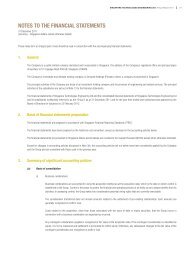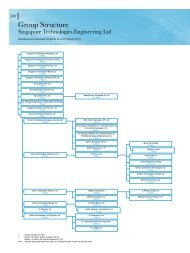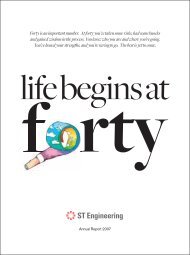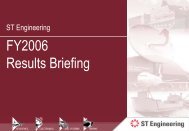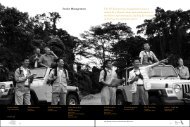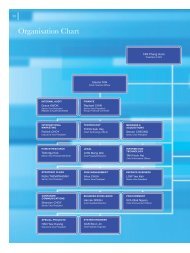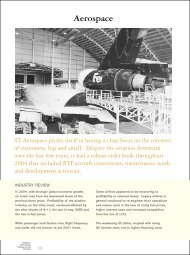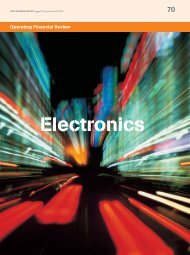Corporate Governance - Singapore Technologies Engineering
Corporate Governance - Singapore Technologies Engineering
Corporate Governance - Singapore Technologies Engineering
- No tags were found...
You also want an ePaper? Increase the reach of your titles
YUMPU automatically turns print PDFs into web optimized ePapers that Google loves.
<strong>Corporate</strong> <strong>Governance</strong>The Company’s corporate governance framework reflectsthe commitment of its Board and management to build atrusted and respected organisation supported by a soundsystem of practices and processes that regulates the conduct ofBoard affairs, the Board’s accountability to shareholders andmanagement’s accountability to the Board.The <strong>Corporate</strong> <strong>Governance</strong> Report below describesST <strong>Engineering</strong>’s corporate governance processesand activities in 2004 with specific references tothe Principles of the <strong>Singapore</strong> <strong>Corporate</strong><strong>Governance</strong> Code.Board’s Conduct of its Affairs and Independence ofthe Board (Principles 1, 2 and 3)The Board’s key responsibilities include providingleadership and guidance to management oncorporate strategy, business directions, acquisitionsand divestments, risk policy and implementation ofcorporate objectives. The Board is aided in its tasksby Board Committees which have been established tofocus on the key areas of oversight.The Board comprises 11 directors and an alternatedirector.The Chairman is Mr Peter Seah, a non executive directorindependent of management. He was the Presidentand CEO of parent company <strong>Singapore</strong> <strong>Technologies</strong>Pte Ltd (STPL) until it restructured and ceasedoperations on 31 December 2004.As a non executive director, Mr Seah is free fromany relationship with the executive management ofthe Company that could materially interfere with theexercise of his independent judgment. However, inthe context of Guidance Note 2.1 of the <strong>Corporate</strong><strong>Governance</strong> Code, Mr Seah will not be regarded asan independent director for the time being as he is “adirector being employed by the company or any of itsrelated companies for the current or any of the pastthree financial years”.The President and CEO is Mr Tan Pheng Hock, who isan executive director.Ten of our directors are non executive of whom theBoard has determined that five are independentdirectors. These independent directors are Mr KohBeng Seng, Mr Venkatachalam Krishnakumar, Dr PhilipPillai, Mr Winston Tan and Mr Lucien Wong.The Company’s independent and non executivedirectors’ contributions to Board deliberations havebeen objective and useful. An independent mindeddirector can constructively challenge and guidemanagement without being adversarial in approach.The Board offers alternative viewpoints in a positivemanner, working with management to achieve successfor the Company.<strong>Singapore</strong><strong>Technologies</strong><strong>Engineering</strong> LtdAR 2004 24
During the year, Mr Tan Guong Ching, an independentdirector, retired at the Company’s Annual GeneralMeeting (AGM) upon the expiry of his term ofoffice and did not stand for re-election. Mr Tan wasChairman of the Business Investment and DivestmentCommittee and a member of the Executive Resourceand Compensation Committee (ERCC). He had servedon the Board since its inception in 1997 and theBoard and management are deeply appreciative ofhis unstinting support and contributions. Mr Tan’sassociation with the company began in April 1992when he was appointed to the Board of <strong>Singapore</strong><strong>Technologies</strong> Marine, a subsidiary of ST <strong>Engineering</strong>.Mr Lim Chin Beng succeeded Mr Tan as Chairman(co-opted) of the Business Investment and DivestmentCommittee on 15 July 2004.The Board held a total of four meetings during theyear, two of which, in accordance with its planningcycle, were for the approval of the FY2003 resultsand release of half year results. Two special Boardmeetings were held to specifically consider the businessgrowth strategies of the Group.Board Committees (Principles 4, 7 and 11)Supporting the Board are the following BoardCommittees:• Audit Committee• Business Investment and Divestment Committee• Executive Resource and Compensation Committee• Nominating Committee• Budget and Finance Committee• Research, Development and Technology Committee• Senior Human Resource Committee• Risk Review Committee• Tenders CommitteeThe composition of the Board Committees is found onpage 31.Board Selection, Training and Evaluation ofPerformance (Principles 4 and 5)The Nominating Committee is responsible foridentifying and selecting new directors and the reelectionof directors due for retirement by rotation atthe AGM. Its members are Mr Peter Seah (Chairman),Dr Philip Pillai and Mr Venkatachalam Krishnakumar.The Nominating Committee has the same membersas the ERCC. This is because both committees sharesimilar objectives of searching for talent and expertiseto enrich the Board and to strengthen management.During the year, four Nominating Committeemeetings were held to approve the format of anannual independent questionnaire for independentdirectors, adopt a Directorship Review Policy andreview the membership of the Board and BoardCommittees in the Company and its key subsidiaries.The Committee decided not to fix a term of office fordirectors. Instead, it provided for a regular reviewof the Board composition to ensure that suitabledirectors are appointed to address the relevant industryand business needs of the Company and its keysubsidiaries. The Committee determined that the Boardis of an appropriate size to meet the objective ofbringing a balance of skills and experience to bear onthe deliberations of the various Board Committees. Anexpertise considered useful as a criterion for selectionto the Board was “knowledge of security” in thecontext of the nature of the Group’s business.Informal reviews of directors of the Board areundertaken by the Nominating Committee when adirector is due for retirement and re-election.At each AGM, one third of the directors with thelongest term in office is required to retire and submitfor re-election. Mr Venkatachalam Krishnakumar,Dr Philip Pillai, Mr Lucien Wong and Mr Tan PhengHock will retire and submit themselves for re-electionat the Company’s forthcoming AGM under Article 98 ofits Articles of Association.25TheEnterpriseInstinct
<strong>Corporate</strong> <strong>Governance</strong>ST <strong>Engineering</strong> subscribes to the principle that alldirectors including the President and CEO shouldretire and submit themselves for re-election at regularintervals and at least once every three years. This isone of the principles in the <strong>Corporate</strong> <strong>Governance</strong>Code (Guidance Note 4.2). ST <strong>Engineering</strong> is an earlyadopter of this principle. It amended its Articles ofAssociation in 2002 to require all directors, includingthe CEO of the Company, to retire by rotation. Mr TanPheng Hock is now due for retirement and is submittinghimself for re-election.On appointment, new directors are given a briefingby the President and CEO on the strategies of theCompany and its key subsidiaries. From time totime, seminars on updates to the relevant laws andcorporate governance are organised for the benefit ofthe directors and management. The Board consistsof members with backgrounds in finance, banking,technology, legal and management skills. Each directorbrings to the Board an independent and objectiveperspective to enable balanced and well considereddecisions to be made.Access to Information (Principle 6)In accordance with this principle, the Board receivesmonthly reports providing updates on key operationalactivities and financial analysis. The Board also hasunrestricted access to the President and CEO, theChief Financial Officer, management and the CompanySecretary as well as the internal and external auditors.The Board can also seek independent professionaladvice if deemed necessary.Procedures for Developing Remuneration PoliciesLevel and Mix of RemunerationDisclosure on Remuneration (Principles 7, 8 and 9)The ERCC performs the role of the RemunerationCommittee. During the year, Mr Tan Guong Chingstepped down from the ERCC when he retired at theCompany’s AGM. Mr Ng Kee Choe also stepped downas a co-opted member. We thank Mr Tan Guong Chingand Mr Ng Kee Choe for their invaluable contributionsto the ERCC. Mr Venkatachalam Krishnakumar hasreplaced Mr Tan Guong Ching on the Committee.The ERCC members are all non executive directors.Apart from Mr Peter Seah who is independent ofmanagement, the other members of the ERCC areindependent directors.The ERCC has access to professional advice fromappropriate external advisors as and when it deemsnecessary. The ERCC may meet with these externaladvisors without management being present. Alldecisions at any meeting of the ERCC shall be decidedby a majority of votes of the ERCC members presentand voting (the decision of the ERCC shall at all timesexclude the vote, approval or recommendation of anymember who has a conflict of interest in the subjectmatter under consideration).The ERCC has been authorised by the Board to carryout the following key duties and responsibilities:• Review and establish executive remuneration policy;• Approve the remuneration package and service termsfor senior executives;• Approve equity based incentive share plans and thegrant of performance share awards and targets forsenior executives;• Approve non executive director remunerationstructure.The ERCC met four times in 2004. Its key activitiescentred on the assessment and development ofthe management team, target setting, and thedetermination of their compensation, incentives planand award.In May, the ERCC endorsed the creation of an ExecutiveOffice to support the Group’s push for growth,especially in the international markets. This wassubsequently approved by the Board. The Executive<strong>Singapore</strong><strong>Technologies</strong><strong>Engineering</strong> LtdAR 2004 26
Office, comprising the President and CEO, two DeputyCEOs, and the Chief Financial Officer, will strengthenthe execution of the globalisation strategy and providebetter focus on customers and growth areas. The twoDeputy CEOs were promoted from within the Group,an endorsement of the confidence of the Board in themanagement team and the strength of talent in theGroup.The Committee also reviewed and approved the grantof share options and conditional performance shareawards under ST <strong>Engineering</strong>’s approved share plans.The Group has set out a groupwide cross section ofexecutives’ remuneration by number of employeesfrom $100,000 upwards in bands of $50,000 upto $250,000 on page 188. This is a comprehensiveanalysis detailing remuneration for up to 1,000 ofits key employees instead of only for a small groupof selected individuals. It therefore gives a betterperspective of the remuneration pattern in the Group.The Senior Human Resource Committee, chaired by MrPeter Seah, comprises Mr Tan Pheng Hock, Lieutenant-General Ng Yat Chung and Dr Tan Kim Siew. Duringthe year, it met twice to review the development ofsenior staff as well as those staff with the potential tohold senior positions in the Group. During the year,the Committee enhanced its system of identifying andscreening talent to be groomed for senior positionsthrough a framework of eight leadership competencies.The Committee also reviewed succession plans for keypositions in the Group.Accountability (Principle 10)The Board places importance on its relationship withshareholders as it is accountable to them for theGroup’s performance.Shareholders are required to approve directors’fees and also the appointment and re-appointmentof auditors.The ST <strong>Engineering</strong> Boardprovides leadership andguidance on corporatestrategy, business directions,acquisitions and divestments,risk policy and implementationof corporate objectives.Directors and key senior executives of the Group areprohibited from dealing in ST <strong>Engineering</strong> shares twoweeks before the announcement of ST <strong>Engineering</strong>’sfirst quarter, half year, third quarter and full yearresults up to the date of the announcement of theresults. Additionally, all directors of the Group and itsemployees are required to observe the insider tradinglaws at all times.The directors’ interests in shares of ST <strong>Engineering</strong>and its related companies during the year are foundon pages 97 to 106.Audit Committee (Principle 11)The Audit Committee comprises Mr Koh Beng Seng,Dr Philip Pillai and Mr Venkatachalam Krishnakumar.All the members of the Audit Committee areindependent directors. The Audit Committee held fourmeetings during the year including a session with theexternal and internal auditors, without management,to review FY2003 results.The Audit Committee reviewed and recommended tothe Board the release of the full year and half yearfinancial statements, and considered and approved the2004 Audit Plan and the 2004 Internal Audit (IA) Plan.It also reviewed internal control procedures, InterestedPerson transactions, corporate guarantee status andnoted updates on the risk review undertaken by theRisk Review Committee. With delegated authority by27TheEnterpriseInstinct
<strong>Corporate</strong> <strong>Governance</strong>the Board, the Audit Committee also met and approvedthe release of the financial results for the first quarterand third quarter of 2004.In the first meeting in 2005, the Audit Committeereviewed the audit observations with the externalauditors for the financial statements for FY2004 audit.The Audit Committee also met with the external andinternal auditors, without management, to review 2004results. There were no major issues highlighted andthe auditors confirmed that they would provide anunqualified report.The Audit Committee reviewed the nature and extentof non audit services provided by the externalauditors during the year which included tax services.It was satisfied that the quantum of services was notsignificant enough to call into question the externalauditors’ independence.The Audit Committee also reviewed the performanceof the external auditors. It recommended to the Boardthe re-appointment of Ernst & Young as auditors forFY2005, after having been satisfied with its standardsof audit, independence and objectivity.The Audit Committee was supported in its work bythe audit committees of the four main subsidiaries.The respective Chairmen of the audit committees ofthe four subsidiaries were invited to attend the AuditCommittee meetings of ST <strong>Engineering</strong> so as to havea clear understanding of policies made at the holdinglevel and to give feedback from the subsidiaries’ auditcommittees.The Audit Committee has full authority to commissionand review findings of internal investigations intomatters where it is alerted of any suspected fraudor irregularity or failure of internal controls orinfringement of any law likely to have a materialimpact on the listed Group’s operating results. It caninvestigate any matter within its terms of reference andwith the full cooperation of management.The mix of independentand non executive directorscontributes to useful andobjective board deliberations.An independent mindeddirector can constructivelychallenge and guidemanagement without beingadversarial in approach.Internal Controls (Principle 12)Internal Audit (Principle 13)The Audit Committee oversees and appraises thequality of the audit effort of the Company’s IA function.The IA function in 2004 was carried out by the GroupInternal Audit (GIA), which resided in STPL. Duringthe year, GIA planned its IA work in consultation with,but independent of, management. GIA attended everyAudit Committee meeting of ST <strong>Engineering</strong> andits subsidiaries and reported on its IA work at suchmeetings. In addition, the Audit Committee met GIAat least once during the year without the presence ofmanagement.The 2004 IA Plan, which was approved by the AuditCommittee, identified the broad business risks for focusin the Business Continuity Plan to be drawn up underthe purview of the Risk Review Committee. When therisk processes are finalised and approved by the Board,IA will monitor and audit the risk processes.<strong>Singapore</strong><strong>Technologies</strong><strong>Engineering</strong> LtdAR 2004 28
During the year, GIA made audit visits to overseassubsidiaries in accordance with their annual IAschedule. Post acquisition audit reviews of significantinvestments were made to ensure the objectives ofthe acquisitions were met. There were no significantcontrol issues highlighted by GIA.The Board, through the Audit Committee, the Presidentand CEO and the Chief Financial Officer, considersthat the Group’s framework of internal controlsand procedures is adequate to provide reasonableassurance of the integrity, confidentiality andavailability of critical information and the effectivenessand efficiency of operations, safeguarding of assetsand compliance with rules and regulations. It is alsosatisfied that problems are identified on a timely basisand there is in place a process for follow up actions tobe taken promptly to minimise unnecessary lapses.With STPL ceasing to be the parent company ofST <strong>Engineering</strong> with effect from 31 December 2004,GIA has ceased to exist as a department. For 2005,the Company has set up its own IA department, headedby a qualified professional, reporting directly to theAudit Committee of ST <strong>Engineering</strong>. The IA departmenthas engaged the services of an external IA serviceprovider to supplement its limited resources, skills andcompetencies so as to achieve the objectives of theIA function.Risk ManagementThe Risk Review Committee, chaired by Mr WinstonTan, comprises LG Ng Yat Chung, Mr Lucien Wong,Mr Venkatachalam Krishnakumar, Mr Tan Pheng Hockand Mr Chang See Hiang, a co-opted member andBoard Director of <strong>Singapore</strong> <strong>Technologies</strong> Aerospace.The Committee has commissioned a consultancy firmto conduct a Value at Risk study of the risk exposuresof the Group. The nature and types of risks in the fourbusiness segments of ST <strong>Engineering</strong> will be identifiedand thereafter internal controls will be refined and newcontrols, where relevant, will be put in place to enablemanagement to better manage significant risks.The consultant’s findings will be reviewed by the RiskReview Committee before submission to the Board.The section on risk management is found on pages88 to 90.In 2003, GIA introduced the concept of ControlSelf-Assessment (CSA) in ST <strong>Engineering</strong>. CSA is amethodology that helps management to identify andmanage risks. It has structured processes which tapinto the knowledge and experience of staff to selfassess the risks and controls of their businesses andthe systems and processes employed. As a follow up tothe two pilot CSA projects which were launched in twosubsidiaries with the help of external facilitators, GIAcarried out four CSA projects in four of the Company’ssubsidiaries during the year.Budget and FinanceBudgets prepared by the respective subsidiaries areconsolidated at the ST <strong>Engineering</strong> level and presentedto the Budget and Finance Committee for review andrecommendation to the Board for approval.During the year, the Budget and Finance Committeeheld three meetings. Chaired by Mr Lucien Wong, theCommittee members are Mr Quek Poh Huat, Dr TanKim Siew and Mr Tan Pheng Hock. The Committeealso reviewed the first quarter, half year and thirdquarter financial statements of the Group, as wellas the forecast for FY2004 against the budget atevery quarter.Business Investment and Divestment CommitteeThe Business Investment and Divestment Committeecomprises Mr Lim Chin Beng as co-opted member andChairman, Mr Tan Pheng Hock, LG Ng Yat Chung,Mr Winston Tan and Mr Quek Poh Huat.29TheEnterpriseInstinct
<strong>Corporate</strong> <strong>Governance</strong>All ST <strong>Engineering</strong> directors,including the CEO, retireand submit themselves forre-election at regular intervalsat least once every three years.ST <strong>Engineering</strong> was an earlyadopter of this principle.During the year, the Business Investment andDivestment Committee, by way of a circular resolution,approved a share swap arrangement which involved thedivestment of an overseas subsidiary in exchange fora stake in the purchasing company, an overseaslisted company.present at the AGM to assist the directors inanswering questions on audit related matters fromshareholders. The Group fully supports the <strong>Corporate</strong><strong>Governance</strong> Code’s principle to encourage activeshareholder participation.The Group has also been supporting investor educationprogrammes organised by the Securities InvestorsAssociation <strong>Singapore</strong> (SIAS) to enable investors togain competency in reading and interpretinginformation in annual reports and other financialdocuments. The Group also engages in regulardialogue with SIAS for feedback to improve itsdisclosure and transparency standards.Financial and other information are made available onthe Company’s website at http://www.stengg.com andthese are regularly updated.Communication with Shareholders (Principle 14)Greater Shareholder Participation (Principle 15)The Group believes in prompt disclosure of informationto its shareholders. In addition to quarterly livewebcasts of its results and briefings to the mediaand investment analysts, the Investor Relations team,together with the President and CEO and ChiefFinancial Officer, participated in roadshows in HongKong, <strong>Singapore</strong> and the US during the year to ensurethat the investing community receives a balanced andupdated view of the Group’s performance and business.The Board members attend AGMs and ExtraordinaryGeneral Meetings where shareholders present are givenan opportunity to clarify or question the Board onissues pertaining to the resolutions proposed beforethey are voted on. The external auditors are also<strong>Singapore</strong><strong>Technologies</strong><strong>Engineering</strong> LtdAR 2004 30
SINGAPORE TECHNOLOGIES ENGINEERING LTDBOARD COMPOSITION AND COMMITTEES(As at 31 December 2004)Audit CommitteeBusiness Investment and Divestment CommitteeExecutive Resource and Compensation Committee/Nominating Committee*Budget and Finance CommitteeResearch Development and Technology CommitteeSenior Human Resource CommitteeRisk Review CommitteeTenders CommitteeBoard MembersMr Peter SEAH Lim Huat C CMr TAN Pheng Hock M M M M MMr KOH Beng SengCLieutenant-General NG Yat Chung M M MDr TAN Kim Siew M MProfessor LUI Pao ChuenMr Winston TAN Tien Hin M M CMr Lucien WONG Yuen Kuai C MDr Philip Nalliah PILLAI M MMr QUEK Poh Huat M MMr Venkatachalam KRISHNAKUMAR M M MBrigadier-General BernardTAN Kok Kiang +CRolling list of any 3 Board DirectorsNon Board MembersMr LIM Chin BengMr CHANG See HiangCCCMDenotes:C – Chairman, CC – Co-opted Chairman, M – Member, CM – Co-opted Member* The members of the Executive Resource and Compensation Committee and the NominatingCommittee are the same.+ Alternate director to Lieutenant-General NG Yat Chung31TheEnterpriseInstinct



